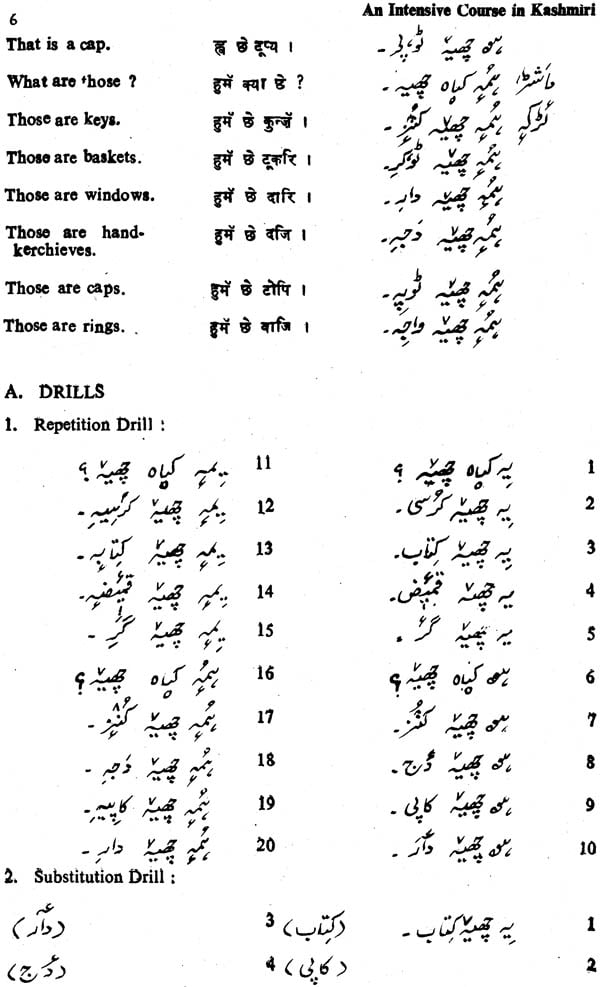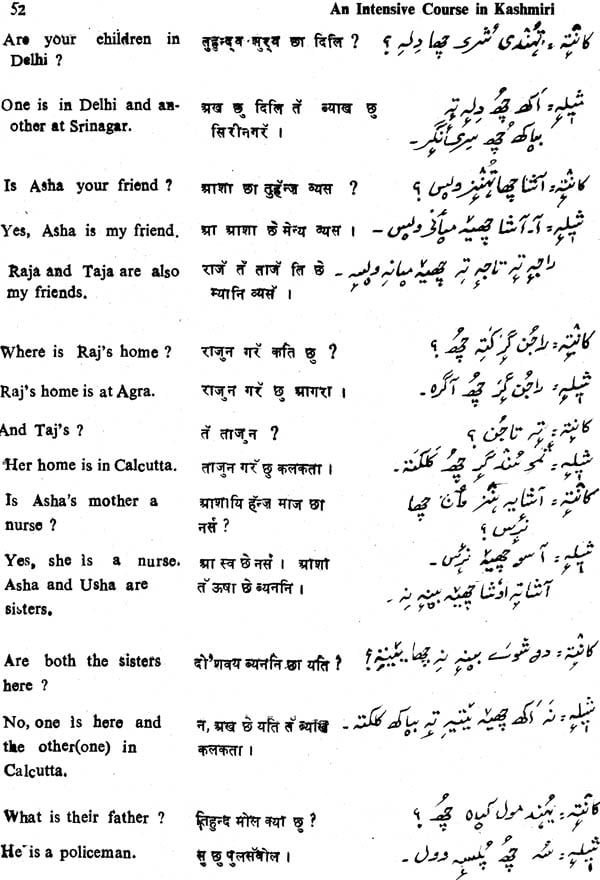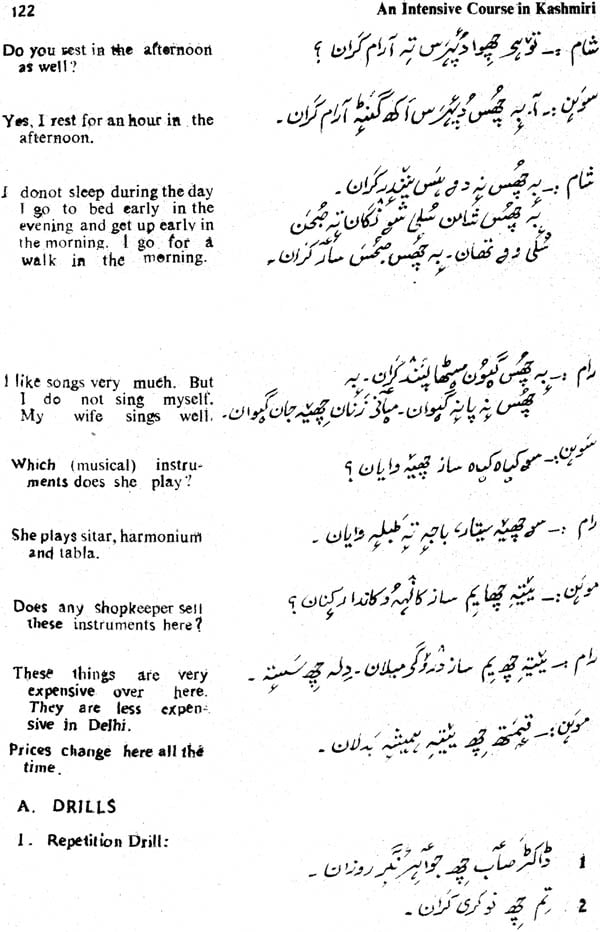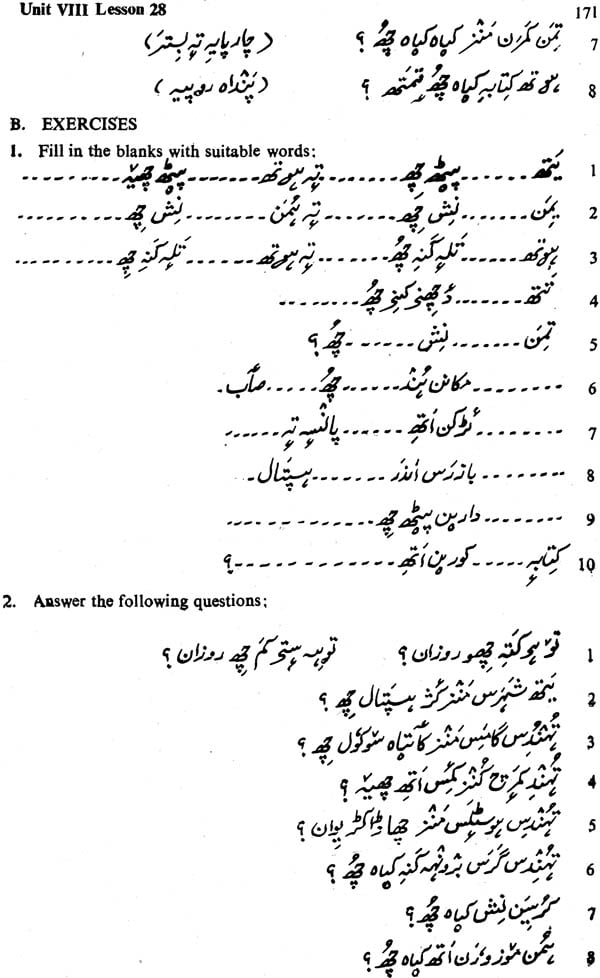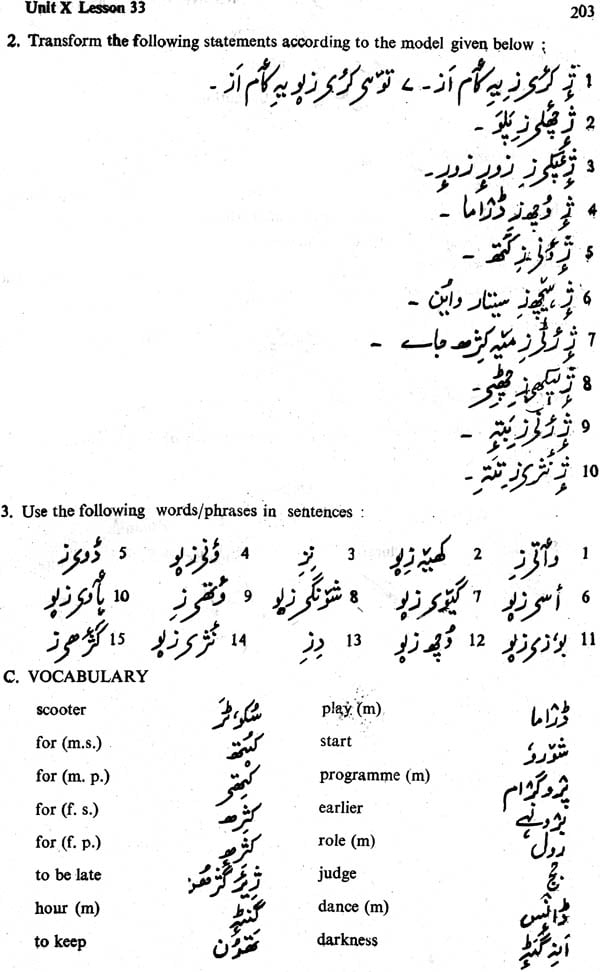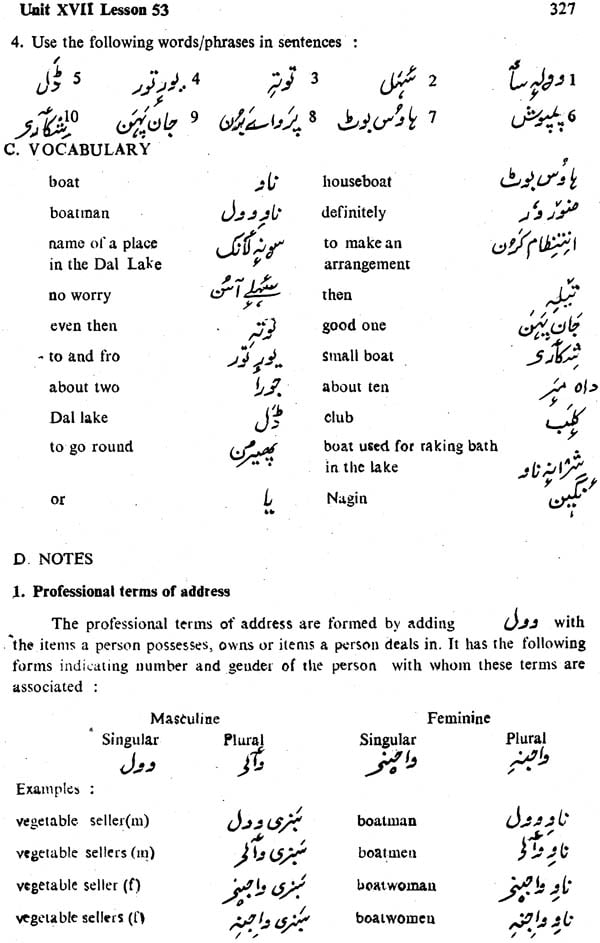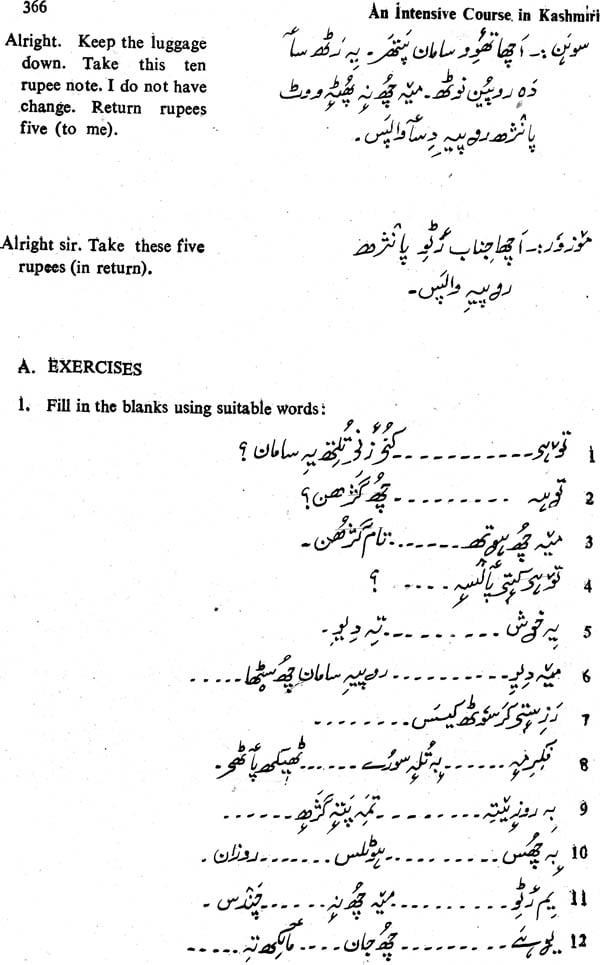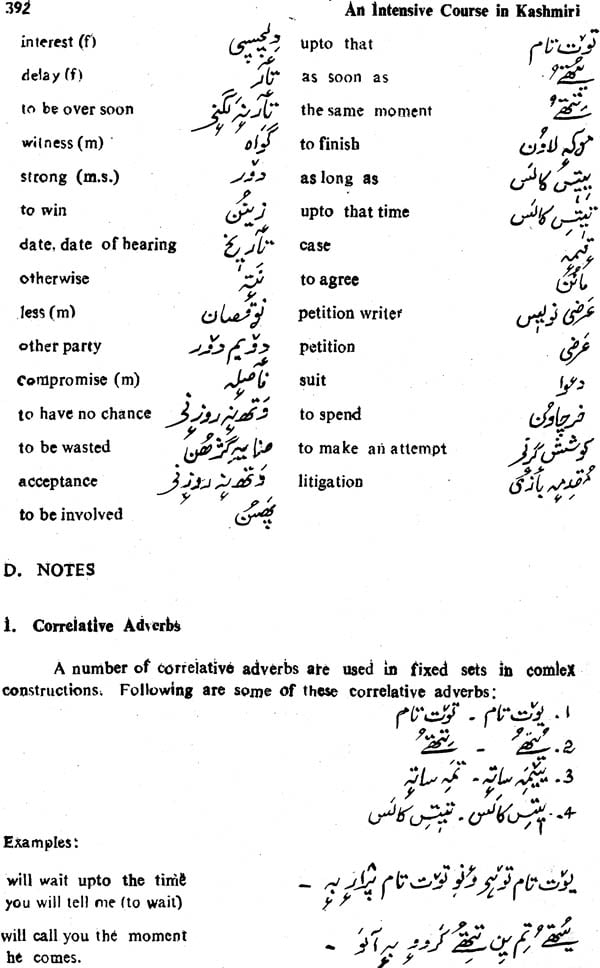
An Intensive Course in Kashmiri (An Old and Rare Book)
Book Specification
| Item Code: | NAK154 |
| Author: | Omkar N. Koul |
| Publisher: | Central Institute Of Indian Languages, Mysore |
| Language: | Kashmiri Text With English Transaltion |
| Edition: | 1985 |
| Pages: | 487 |
| Cover: | Hardcover |
| Other Details | 9.5 inch x 7.0 inch |
| Weight | 730 gm |
Book Description
Language teaching is an ancient profession. India has a long tradition of teaching classical languages following the Gurukula system. The language teaching was not independent of teaching philosophy, logic grammar and poetics. It addressed itself to a selected group in the society and thus was shaped in method logy and objective by the motivations and purposes of this group.
Language teaching has developed as a sub discipline within applied linguistics in modern times. All the segments of the society learn languages, which may be the mother – tongue and/or the second language. The importance of language skills in the educational process, economic activities and cultural assimilation has been recognised. It is a challenge to the linguists to develop models, methods and materials which could meet each and every need of different learners and are suitable to the different learning abilities and aptitudes.
Teaching of Indian languages as a second language to fellow Indians is fast developing as an area demanding immediate attention and work. The Indian languages are taught as a second language under the Three Language Formula in schools. It is necessary to train teachers to teach the Indian language as second language in schools. The Regional Language Centres of the Institute cater to this need of manpower development in the area of second language teaching. They offer an intensive course of ten months in a non-native Indian language to the school teachers. The teaching materials for the courses include conventional as well as audio-visual materials. They were used in the classes for more than a dicade and now have been finalized on the basis of experience with various batches of teacher trainees. They are now brought out for wider use. It is hoped that they will be useful for any adult learner of an Indian language.
This book however is specifically designed for an Indian adult learner taking into account commonness between Indian languages and share cultural experiences. The course divided into 3 terms has different materials for each term. The first set of materials goes by the name intensive Course. This course will be available in 13 major languages of Indian viz, Kannada, Tamil, Telugu, Malayalam, Asamese, Bengali, Oriya, Marathi, Gujarati, Sindhi, Punjabi, Urdu and Kashmiri.
The Institute will be happy if these materials contribute to the development of teaching of Indian language as second language as a special sub-discipline within language teaching. From the practical point of view, the Institute will be happy if these materials help more Indians to become bilingual in other languages of this country.
In language teaching the notions of mother tongue, first language second language and foreign language are understood in terms of different language teaching and or learning situations. The mother tongue is the language naturally acquired by the child from the early family atmosphere and environment the child is first exposed to. The first language can be the mother tongue of a child but it need not always be so. This term is usually associated with the native language of a speech community, region or a state where it is used for wider communication and may be used in education, mass media and administration.
A language taught in its natural environment to the native speakers of the language is indeed a mother tongue/first language teaching and learning situation, when the same language is taught to the non-native learners of the language it is categorised as a second/foreign language teaching and learning situation. In the second language teaching situation, the language learning does not remain confined to the classroom only there is a continuous re-inforcement from the environment outside the classroom. The second language learners learn language faster when it is taught in its natural environment. When a language is taught in an alien or foreign environment to the non-native learners, or in other words, when the teaching and learning remains confined only to the class room and there is no immediate re-inforcement from the environment, the language teaching and learning situating is characterised as a foreign language teaching and learning situation.
Kashmiri is being taught as a second language at the Northern Regional Language Centre, Patiala since 1971. There has never been any other serious attempt for teaching and learning of his language as a second foreign language earlier. (Of course, it was once taught as a short term course at a summer school of linguistics at the University of Illinois during 1967). As a result only a limited number of pedagogically oriented materials in the form of language courses and supplementary materials have been produced so far. Kachru (1973) makes first serious attempt in this regard.
Objectives
The present intensive course in Kashmiri is meant primarily for the teacher trainees in Kashmiri at the Northern Regional Language Centre of the Central Institute of Indian Language. the centre offers an intensive training programme for non-native adult learners. The entire trading programme has a duration of 1100 clock hours. This period is divided into three stages namely Basic Course, Intermediate Course and advanced Course. The present book is intended to be used mainly in the Basic – Course stage which extends over 14 weeks and has about 450 clock hours of Instruction. The intensive course has been designed keeping in view the objectives of the course. At the end of the course the learners are able to achieve the following objectives:
To perceive and reproduce the sounds and their meaningful sequences.
This means (a) identification of sounds in their meaningful sequences
(b) discrimination of the sounds in their meaningful sequences, and
(c) oral reproduction of the sounds in their meaningful sequence.
To from sentences orally from given patterns and lexical items.
To converse with their teachers and fellow trainees on specified topics under controlled situations.
To narrate specified events and topics orally.
To read simple and graded passages with comprehension. This includes (a) the recognition of the letters of the alphabet in isolation and in sequence, and (b) the comprehension of passages containing simple sentences.
To write simple sentences and guided compositions on specified topics. This includes (a) the writing of the letters of the alphabet in the initial stage followed by words and sentences and (b) the writing of guided compositions on specified topics.
This intensive course is meant to be used as the prescribed text along with other supplementary materials like kashmiri Phonetic Reader, State School Reader in Kashmiri Level I during the Basic Course. The first objective of the course, can be achieved by using the phonetic drills given in the Phonetic Reader. Similarly the Kashmiri script can be learnt by using the State School Reader Level I.
The script is taught simultaneously with the Spoken language from the very beginning. It is expected that the learners take about 15 to 20 clock hours of instruction in learning the script. Since most of the Indian learners of Kashmiri are familiar with the Devanagri script transcription of texts of the first ten lessons has been give in the Devanagri as well using extra symbols to represent different Kashmiri sounds. The Kashmiri alphabet has been give immediately after this introduction.
Structure of the Book
This Intensive Course consists of 24 units which contain a total of 70 lessons. Usually one major structure has been introduced in each unit and its related patterns and teachable items are given in the lessons comprising the unit. Review lessons are given wherever felt necessary. The review lessons review and reinforce the structures an teachable items introduced earlier.
Each lesson consists of text in the form of a dialogue which is followed by drills, exercises, vocabulary and notes on grammar. The dialogue introduces a particular structure and a set of teachable items. The drills and exercise reinforce and evaluate the teaching items introduced in the lesson. The vocabulary lists the lexical items introduced in the lesson for the first time. Notes on grammar are provided in each unit.
The text which introduces structures is provided in the form of dialogues. Narrative style is used in the text of review lessons and also in the last two units which provide an over all review of the structures in this style. The texts are provided with English translation. It is to be noted that the English translation given has no one to one correspondence either structurally but is intended only to convey the general meaning.
The text of the lesson is followed by drills and exercises. Drills are provided for the oral practice of the structure and teachable items introduced in the text. They enable the learner to internalise and reinforce the structures and teachable items introduced in the lesson. The types drills introduced in this lesson are: Repetition drill, Substitution drill, Buid-up and expansion drill, Transformation drill Response drill and Questin-Answer drill. Each drill has a specific objective and collectively they contribute to the oral comprehension of the learner. It is to be noted that the drills are designed in such a manner that they can be used as written exercises for the practice in writing, and will supplement the exercises which follow the drills.
| Foreword | v | |
| Editor's Note | vi | |
| Acknowledgement | vii | |
| Introduction | xi | |
| Kashmiri Alphabet | xvi | |
| Unit | Lesson | |
| I | What is this? | 1 |
| This is a chair. | 5 | |
| Animals and birds | 12 | |
| II | Who is he? | 18 |
| How many are they? | 24 | |
| III | Parts of body | 32 |
| He is my brother. | 37 | |
| Is she your sister? | 45 | |
| Is he Ramji's son? | 51 | |
| Mr. Khan | 58 | |
| IV | About a house. | 61 |
| Meeting with a stranger | 68 | |
| About height and weight | 76 | |
| Meeting among friends | 85 | |
| Our city | 91 | |
| V | What are you doing? | 96 |
| I am eating an apple. | 103 | |
| What are you doing? | 109 | |
| I will be studying. | 114 | |
| VI | What do you do? | 121 |
| She works smilingly | 128 | |
| In Delhi | 133 | |
| VII | What is your name? | 137 |
| Do you like this place? | 144 | |
| I am not felling well. | 149 | |
| VIII | Where is the pen? | 155 |
| Where is the ball? | 161 | |
| What is in this Almirah? | 167 | |
| IX | We see with our eyes. | 174 |
| About the routine means of travel. | 180 | |
| Our Garden | 187 | |
| X | Get ready for school. | 193 |
| About a play in school | 199 | |
| At a fruit seller's shop | 205 | |
| About a visit to Simla | 211 | |
| XI | At a hotel | 218 |
| I will go to the bazaar. | 224 | |
| XII | I read this newspaper | 230 |
| When did you come? | 238 | |
| Kasmiri villages | 245 | |
| XIII | Have you read this book? | 249 |
| About a movie | 257 | |
| Had you gone to school? | 263 | |
| XIV | Days of a week | 268 |
| Seasons of Kashmir | 273 | |
| XV | What did you do? | 278 |
| What should I bring for you? | 283 | |
| About weather | 290 | |
| XVI | Is he able to walk? | 297 |
| About a meeting | 303 | |
| XVII | About the construction of a house | 310 |
| On consulting a doctor | 316 | |
| The Dal Lake | 322 | |
| XVIII | Where did you go? | 329 |
| When did you come? | 337 | |
| Did you go to bazaar? | 342 | |
| XIX | About a visit to Kashmir | 349 |
| At a friend's house | 355 | |
| With a coolie | 364 | |
| XX | What do you teach? | 368 |
| A visit to a friend's place | 374 | |
| Preparation for travel | 380 | |
| XXI | On filing a suit | 387 |
| About a visit to Kashmir | 394 | |
| XXII | On return from Kashmir | 400 |
| About Mohan's employment | 408 | |
| XXIII | Kashmir | 415 |
| Lal Ded | 421 | |
| XXIV | Nund Rishi | 426 |
| Badshah | 431 | |
| Word index | 437 |
